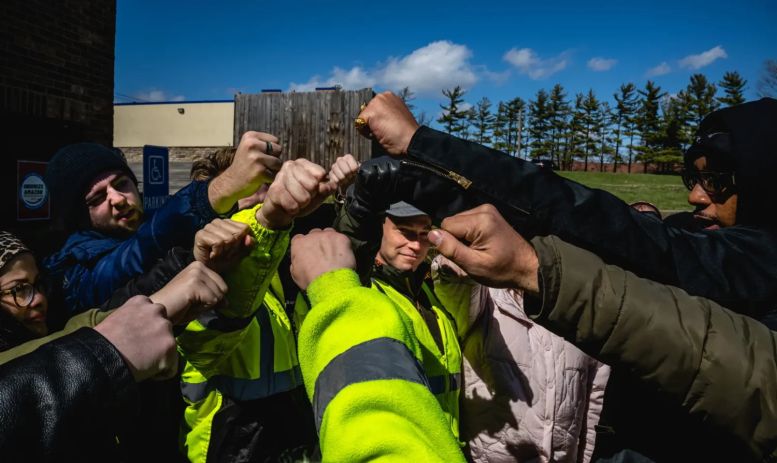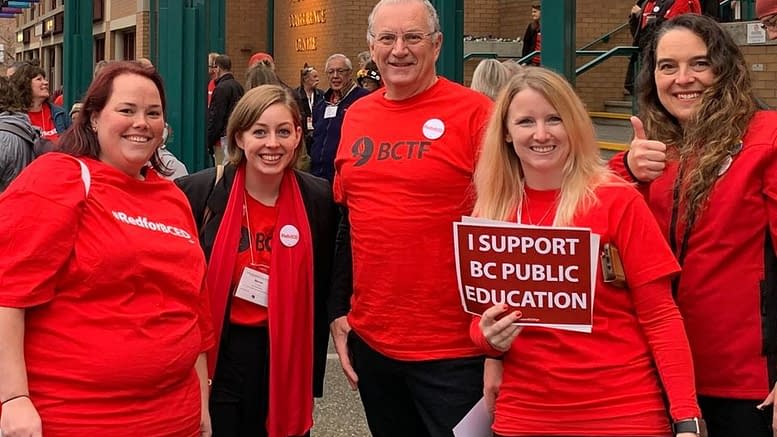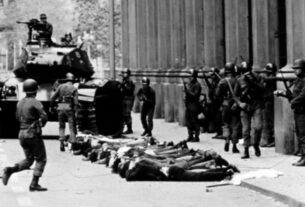Chris Gray is a member of Socialist Alternative in the US.
How Amazon is Fighting Tooth-and-Nail to Stop Workers From Unionizing Its Biggest Air Hub
To Amazon’s corporate suits at their headquarters in Seattle, the KCVG Air Hub in Northern Kentucky is often referred to as the “Death Star.” The massive $1.5 billion facility already handles over 500,000 packages every day. Eventually, it will have 100 parking spaces for planes and will employ 11,000 workers. Amazon plans for 80% of its air freight to be handled by KCVG. The Air Hub is the cornerstone of Amazon’s plan to achieve same-day delivery anywhere in the country.
But within the Death Star of Amazon’s empire, a rebel fighting force is growing. KCVG workers, who joined up with Amazon Labor Union (ALU) and launched card collection in March, are building a bold and uncompromising campaign to unionize the Air Hub. It is, without question, the most important union effort happening in the U.S. right now — winning a strong union at KCVG would set an example for Amazon workers to replicate and adapt to their workplaces across the country.
Card Collection Launches at KCVG
In the parking lot of the Air Hub on March 18, KCVG workers executed a tight balancing act — leading a rally from the bed of a truck, signing up their coworkers on union authorization cards, and defending their action from managers attempting to cut across it.
In the days leading up to the rally, which served as the launch of union card collection at the facility, Amazon made every attempt to shut it down. While the original plan was for workers and community labor supporters to rally together in the parking lot, Amazon issued a ‘cease and desist’ letter and set up barricades and a security checkpoint preventing community members from attending in solidarity. This ‘cease and desist’ notice was intended in particular to prevent leading members of the Amazon Labor Union (ALU), like Chris Smalls, from attending.
Amazon management aimed to whittle down this event as much as they could, even claiming that workers might be in violation of federal aviation policy if they showed up at the rally, an obvious lie. Managers hovered in the elevators as workers walked to their cars to leave work, and they parked their cars on the side of the road, with their sirens blaring, as workers drove towards the rally. The general manager of the facility stood at a checkpoint, checking workers’ badges as they pulled into the parking lot.
Rather than cowering in fear of Amazon’s ‘cease and desist’ threats, workers and the wider community found a way to still come out in force to show Amazon they wouldn’t be bullied. Community supporters and local labor leaders rallied at the edge of Amazon’s property, right by the barricades, chanting in support of the workers who organized their own rally inside. In a powerful display of unity, when the rally was over inside, workers marched out of the parking lot to join union supporters for an energetic press conference.
During and after their rally in the parking lot, members of the KCVG Organizing Committee helped their coworkers sign union authorization cards, while defending their table from attempts by management to shut it down.
“We’re not gonna accept you hovering over workers while they’re engaging in union activity,” said Griffin Ritze, a tug driver at KCVG and member of the organizing committee, to a manager in a video that has now reached over half a million views on TikTok. “So yeah, unless there’s anything else to say, I think we’re done here. If you’d like to talk to our lawyer I’ll put him on the phone.”
The manager seen in the video, a “security expert” shipped in from Texas, claimed the small table, set up outside the entrance to the facility, was a safety hazard and needs to be moved to the opposite side of the parking lot.
“This is not a safety hazard,” Ritze responded. “We’re not gonna accept being shoved to the corner of the parking lot.”
Despite Amazon’s intimidation tactics, dozens of KCVG workers signed union authorization cards that afternoon. In the end, management’s aggressive intimidation backfired, and more workers than ever have expressed interest in the union.
Amazon’s Anti-Union Intimidation Backfired
As workers launched a vibrant card collection campaign, management launched their all-out campaign of bullying and intimidation. All of their tactics are blatantly illegal, but Amazon does them anyway because they have all the lawyers and money in the world, and they can easily deal with fines and penalties later if it means stopping the union effort now.
This is why it’s essential that workers are prepared to organize and stand up to managers every time they try to bully workers. When workers force managers to back down, it massively boosts the confidence of all workers across the facility, no matter how small the win might be.
After pulling off the successful launch of card collection despite intimidation, KCVG workers had renewed confidence. The day after the rally, Amazon’s incompetent managers tried to force ramp workers, who normally load and unload planes, to cover shifts in the package sorting building to save money. However, managers refused to train the workers to do the job safely. Workers stood together in opposition and confronted management for two hours, refusing to work without training. They eventually forced management to back down. After the victory, these workers showed up at the union office ready to make a pro-union video for the campaign’s social media, hoping to inspire more workers to do the same thing.
Withstanding Amazon’s Anti-Union Machine
At the launch rally, workers got a taste of how far Amazon will go to shut down union activity, but Amazon has far more union-busting tools in their belt. And this is just the beginning. They will host captive audience meetings, they will plaster the facility in anti-union posters (at the JFK8 warehouse, they spend $4 million on posters alone), and much more. At LDJ5, Amazon lied to workers about their benefits going away if they unionize. And during the 2021 campaign to unionize the warehouse in Bessemer, AL, Amazon even installed a fake mailbox to collect union votes.
In February, they fired Darryl Richardson, a lead organizer from the Amazon union drive in Bessemer, and they are targeting other workers as well. In January, they fired Edward Clarke, a load planner at KCVG, and other workers for daring to show any support for the union. They would rather pay a fine later than let a union organizer continue building the union. Their main goal is to terrify other workers who are already facing dwindling savings, rising rents, price-gouging food corporations, and rising healthcare costs.
The only way to counteract this is to have a well-organized team that can answer every anti-union lie Amazon tests out and that can demonstrate how to hold their ground against the corporate giant.
It’s essential that the KCVG union drive started out on a footing of confronting management. In order to build a strong union, it’s necessary to act like one and set an example of not bending to the bosses. This includes both demonstrating how workers are stronger taking on managers together than alone, as well as showing how having a union will actually improve workers’ lives.
A crucial way to do this is to make the concrete demands the union will fight for front and center in the campaign. The demands at KCVG are so central to the campaign that they’re pictured on the campaign’s logo, and include a $30/hour starting wage, 180 hours of paid time off, and union representation at all disciplinary meetings.
These bold demands inspire workers, but Amazon also uses them to claim that the union is making “promises it can’t keep.” This was a key line of attack in the campaign to unionize JFK8 in Staten Island, the first unionized Amazon facility in the country. In a recent flyer, KCVG workers reply, “demands are not promises. Demands are clear goals that we democratically decide to all fight for.” This is the approach a fighting union should take. Demands are the anchor of any successful union campaign, and the strategy to win them should be as bold as the demands themselves.
Organizers with the Amazon Labor Union in Staten Island made similar points during their union drive last year: “We can’t promise to win all these things, but we promise to fight for them.”
Building The Shop Team
A crucial part of winning the union at KCVG will be building the strongest possible engagement from workers in the facility. This will mean the creation of a strong shop team, which is a wider team of worker leaders in the facility who are committed to growing the campaign among their coworkers.
In getting more workers involved in actively building the union, the Organizing Committee (OC) is taking time to hold weekly orientations for workers who support the union (or are on the fence). There were four separate orientations during the first week of the drive, each one facilitated by a member of the OC. At the orientation, new union contacts discuss the approach of the union drive, how to approach workers with clear demands, and how to answer Amazon’s anti-union propaganda.
After that, new union contacts learn how to collect union authorization cards. The first step is for them to identify three of their coworkers who they will approach about the union using the opening line: “Do you support a $30/hr starting wage here at KCVG?” After a discussion with their coworkers about demands, they introduce signing a union authorization card. Linking the authorization cards to demands is essential to deal with Amazon’s attempts to confuse workers about what they are signing.
A crucial next step for the campaign will be to ensure that there is the most diverse possible group of union activists involved. KCVG has eight different shifts of workers who do over a dozen very different jobs in two separate buildings. While demands like $30/hr link all workers into a unified struggle, each job type and shift of workers deal with specific workplace issues that also need to be addressed by the union fight.
It is crucial to guarantee every section of the workforce is engaged and represented. This means building a concerted effort to win over workers who speak various languages and represent various ethnic groups inside the facility. A first step in ensuring this balance is making sure all key union material is translated into multiple languages, which has already been a feature of the campaign’s material. The next step will be taking a systematic approach to reaching out to key workers among various sections of the workforce and organizing special meetings in locations where immigrant workers in particular feel comfortable and are able to communicate in their native languages.
Hit Amazon Where It Hurts
The only way to get Amazon to meet the demands of its hyper-exploited workforce across the country is to hit them where it hurts most: in the wallet. This means disrupting Amazon’s profit-making machine, and nowhere is this machine more vulnerable to work stoppage than at KCVG. Organizing this facility will take marches on the boss, strikes, and walkouts. Amazon’s main goal is to protect its bottom line, and until this is threatened, it won’t stop.
A key weapon the union has is support from the wider labor movement and the working class in the area. Three unions, the Ironworkers Local 44, IBEW Local 212, and Laborers Local 265 have made donations to the campaign and mobilized their membership to rallies and events.
In addition, national unions like the Minneapolis Federation of Teachers, the United Federation of Teachers in New York, and the Northshore Education Association in the Seattle area have also made donations. It’s urgent that other unions follow suit. Unionized pilots fly Amazon’s planes, UPS workers and postal workers deliver Amazon’s packages, and building trades workers construct their vast facilities. These unions can directly support the struggle by endorsing the campaign, donating, and most importantly showing up to support any organizing happening at the facility. All of this sets the basis for being able to shut KCVG down to win workers’ demands.
Polls show 70 percent of Americans support unions, and worsening living standards and workplace conditions are pushing workers to take action. However, popularity is not enough to overcome corporations that have decades of union-busting experience under their belts. Never underestimate your opponent, especially an opponent like Amazon. They’ve already shown they will fight a union every step of the way, and like a cornered animal, they will only get more dangerous as the union drive gains more and more support. There are no shortcuts to winning, and we need to remain focused on building a solid team of workers on the shop floor armed with clear demands, a strategy to organize the whole workforce, and most importantly, the willingness to fight.




